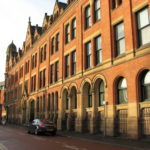
The low, warm winter sun slants in on the four of us as we shuffle our gear on the curb at San Francisco Airport, en route to England and Japan.
I’ve joined engineer Jim Rolin, producer Lori Wright, and director Randy Field outside the International Terminal. We count cases (13 plus carry-ons), then take a moment to bask in the balmy Northern California weather: just under 60 degrees this afternoon, on the fourth day of the new year.
We know that the United Kingdom has just dug itself out of pre-holiday blizzards and freezing snow-and-ice storms that closed down Heathrow Airport in London, our first port of call, for days. Manchester, England, our eventual destination nearly four hours’ drive north of Heathrow, has just a week earlier reported lows in the 20s and predictions of rain and more snow. Tokyo at this point — nearly six days in our future — predicts clear skies, with temps in the 40s.
We take a final breath of Real Air and step into Airline World, a brightly-lit place of bad, stale air and cramped spaces. Especially if you’re 6′ 4″, like me. Or 6′ 8″, like Jim.
Our departure process is routine. We number and count everything at the curb, then wheel all our video and audio gear inside and downstairs to US Customs, where an agent must sign off on our Merchandise Passport, or ATA Carnet.
The carnet is an internationally accepted document which includes a detailed list of our video and audio equipment, certified by Customs, so that we can export it all from the US, import it into and export it from each country we visit, and then bring it all back into the US upon our return, without import duty anywhere. The carnet includes a bond our production company has bought to ensure that we will take the gear out of each country when we leave (not sell it to locals without paying tariffs). For more about carnets, see Shooting Abroad: Paperwork, Passports, X-rays, and Excess Baggage.
This routine is old hat for us because we’ve traveled a lot lately, shooting patient-oriented videos for a global medical company. In the past year, Jim and I have filmed for this client in Belgium, the Netherlands (twice), the UK, Germany, Switzerland, China (twice), Japan, and Brazil. We’ve been accompanied by Randy and Lori most of the time, and by David Rathod and Anne Sandkuhler and Laura Marks some of the time. Plus other shoots in the US.
Excluding any bonuses for frequent flying, I flew nearly 82,000 miles on United alone in 2010, plus a bit on other carriers. Mileswise, my cup runneth over.
After we banter with the Customs agents at SFO (several of whom recognize us now, both on the way out and on the way in), they choose an item from the carnet for inspection, usually our Panasonic Varicam AJ-HPX3700 HD camera body, the most expensive single item listed. They confirm the serial number, then stamp the carnet, and we wheel all our gear up to the United window to check in, discuss seats, weigh and tag all the bags. The heaviest one weighs exactly 50.0 lbs on the airline’s scale, exactly at the limit. Several hover around 49. All is well. Because we all have Premier Executive status in United’s Mileage Plus program, our excess baggage charges are minimal.
We make sure our bags gets tagged to LHR (London Heathrow), count baggage tags, and watch as our bags get loaded on the belt and disappear, then hang about until a baggage porter has wheeled our two largest pieces (a fold-up Magliner luggage cart, and a large flat box about the size of two pizzas laid end to end, which contains shelves for our tech cart) over to the Oversized window.
Our spirits are high as we head for Security. We’re excited about this trip. We’re interviewing a cystic fibrosis patient in Manchester, and a sleep apnea sufferer in Tokyo, in each case highlighting treatment technologies from our client. Our theme is home healthcare. There is no place like home, and advances in medicine make it more feasible for patients to treat their ailments at home. Both stories are potentially interesting and absorbing. We clear Security (Jim gets “puffed” by the full-body scanner; the rest of us just go through the metal detector) and check into the Red Carpet Club, United’s fancy membership lounge, to await our flight.
I decide to run out to buy a bottle of water for the trip, which involves going back downstairs through the Club lobby and into the terminal, then back upstairs to the lounge. As soon as I return, I hear “William Zachary, please report to the Red Carpet Club lobby,” so I run downstairs again.
“William Zachary?” asks the young lady at the counter. Though my last name seems pretty easy to me (it’s pronounced ZAR-chee), it seems to be my fate that some folks will inevitably look at it and say Zachary. Or Zarky. So I agree half-heartedly that that’s my name, and she tells me I’ve dropped my boarding pass, and it’s been found. She hands it over to me. Huh, I’m usually less careless, I think, jamming it into my pocket.
I run back upstairs to my friends, just in time to leave the lounge and head for the plane. As I pass through the Club lobby again, the same young lady calls me over and somewhat indignantly tells me that wasn’t my boarding pass. I look in my pocket. Two boarding passes. One in my real name, for London, another to the real William Zachary, who, thank God, is going somewhere else.
We fold ourselves into the tiny spaces allotted for the long flight, all aisle seats in the Economy Plus section, which affords anywhere from 2-5 extra inches of leg room. I’ll take it. The “extra” is often the difference between bouncing off the plane at the other end, or needing an immediate MRI and knee replacement.
They used to fly us in Business Class on long corporate jobs like this, but that ended in my world about five years ago. We tend to fly a lot on United, not because it’s the best carrier (most of my compadres think the food and service are mediocre at best), but because continued use gets us high Mileage Plus status, which gives us a break on excess baggage for trips like this, and gives us huge bonuses to accumulate miles — so we can fly some more on United.

My family uses the miles. Over the years, we have been to Europe several times and to the East Coast and Canada for numerous family visits. Next month my wife and I will visit cousins in Atlanta for a few days, using United miles for free tickets on partner airline US Airways.
For years I’ve been unable to sleep on planes, but recently I’ve changed my habits. I take a prescription Ambien after the dinner service on the flight and try to watch a movie. I also use an inflatable head support (which I’ve called “nerd pillows” for years), turning it so the opening is at the back and the pillow keeps my chin from falling forward as I nod out. The Ambien makes me a bit drowsy, and usually I’m able to sleep this way for several hours. I do wake up a lot; it’s not perfect, but it’s far better than getting no sleep at all, my chin constantly banging against my breastbone.
Our flight leaves SFO at 7 pm Pacific Time. We arrive 10 ½ hours later at London Heathrow Airport, where it’s now 1:25 pm, having flown east over 5000 miles, across eight time zones. It takes nearly three hours to get through Passport Control (severely understaffed) and Customs (to have our carnet stamped upon entry in the UK). Our Magliner cart and pizza-box shelf case have not arrived, so we arrange for them to be delivered, eventually, to our hotel in Manchester. Andrew Van Hoffelen, who often works as Production Manager on our European shoots, picks us all up in a large van. We step out of Airline World into Real Air again, which is cold and damp (surprise!), load in our gear, and head north on the Motorway.
TO BE CONTINUED






I can’t wait to see what happens next. My sympathies go to you tall people, especially when traveling for work! 5’3″ travel is bad enough.
Bonnie, stay tuned for more!